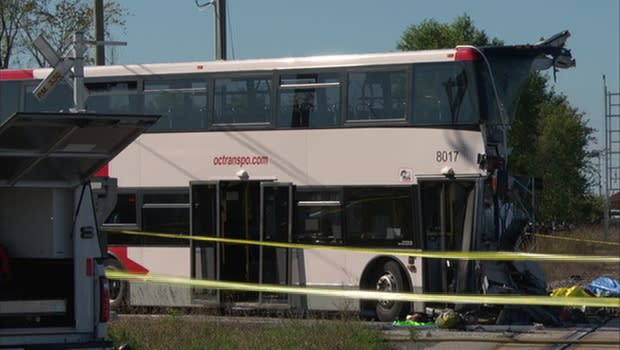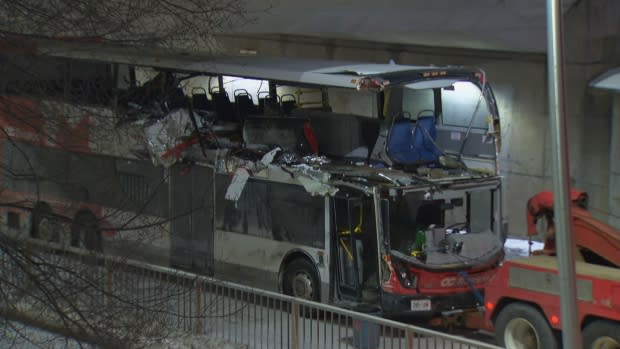Why city buses aren't crash-tested
When an OC Transpo bus collided with a Via Rail train in 2013, the front of the bus was torn off and its left side was peeled back like the lid of a sardine tin.
The bus in that collision — like the bus in this month's fatal crash at Westboro station — wasn't required to meet the same crash standards that smaller vehicles must meet.
In fact, in Canada, vehicles of that size aren't crash-tested at all. Government regulations exempt vehicles over 11,793 kilograms from the same cras-testing that smaller vehicles must undergo.
"The primary reason why there are no crash tests is because there haven't been a real societal need to protect passengers in bus incidents," said Jamie Catania, president at crash reconstruction firm 30 Forensic Engineering.
Buses aren't involved in a lot of collisions, Catania said — and when they are, passengers "don't normally get injured."
Changes recommended
After the 2013 crash in Barrhaven, the Transportation Safety Board of Canada recommended a number of changes, noting that better bus design may have offered stronger protection.
"The tearing away of the bus structure ultimately resulted in the driver, the driver station and seat as well as eight passengers and four passenger seats on the upper deck being ejected from the bus," the agency wrote in its report in 2015.
The board also found that it didn't require a great deal of force to do all that damage.
"The breakup of the bus front structure did not require considerable impact energy. The front structure was not designed to provide impact protection," it said.
Following the TSB's recommendations, Transport Canada has been working for nearly two years to find and buy a model bus it could perform crash tests on to come up with its own recommendations, but it's been a complex process.
Transport Canada sets standards for cars, vans and SUVs, dictating how they must perform in front impact, side impact and rollover crashes. There are also rules for school buses, but larger vehicles such as transit buses are exempt.
How it breaks down
Transport Canada has different standards for different types of vehicles, usually based on the vehicle's weight. The standards set out requirements for vehicles, from major items such as braking performance to smaller ones such as how icons are displayed on your instrument panel.
Here's a look at some of the crash standards for different kinds of vehicles.
Cars, SUVs and vans
Transport Canada's standards set out rules for components such as the steering column, requiring that it only moves so far back in a typical collision.
The agency also spells out how far the roof can cave in during a standard rollover.
Seatbelts and airbags also have to meet certain requirements to ensure they protect passengers.
School buses
The rules for school buses dictate seats must remain attached in a crash, and must not move more than a few centimetres.
The padding on school bus seats must also remain intact during a crash.
School buses must have a rear door that opens outward in an emergency.
Transit buses
Transport Canada doesn't require the same crash-testing as other vehicles.
They must have clearly-labelled emergency exits on the roof to allow passengers to escape if the bus falls on its side.
They also require electronic stability control, a system meant to reduce skidding in large vehicles.
Heavier vehicles tend to fare better
Catania said heavier vehicles tend to fare better in collisions because they're usually the larger object.
"They tend to keep moving when they hit something, as opposed to coming to an abrupt stop," he said.
However, in the 2013 Fallowfield station crash, the train that collided with the bus was by far the heavier vehicle. In the Westboro station crash, the bus collided with a steel-framed bus shelter.
Catania said he understands people will want to see changes after the most recent crash in Ottawa, and said this incident may spur Transport Canada to move faster on new regulations.
"The concern I have is that you can't protect against every single eventuality," Catania said. "As horrific as [the Westboro crash] was in Ottawa, two weeks ago no one would ever have seen that coming."



